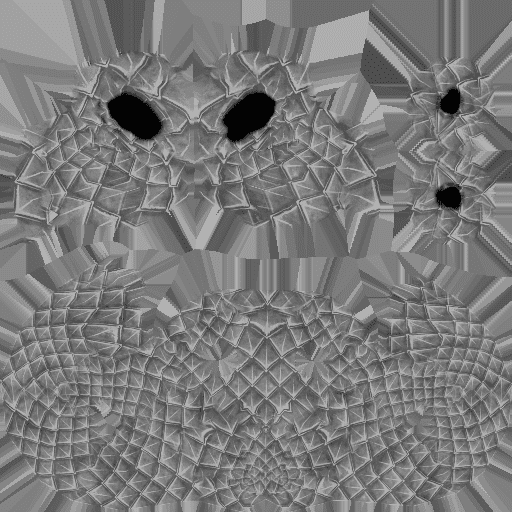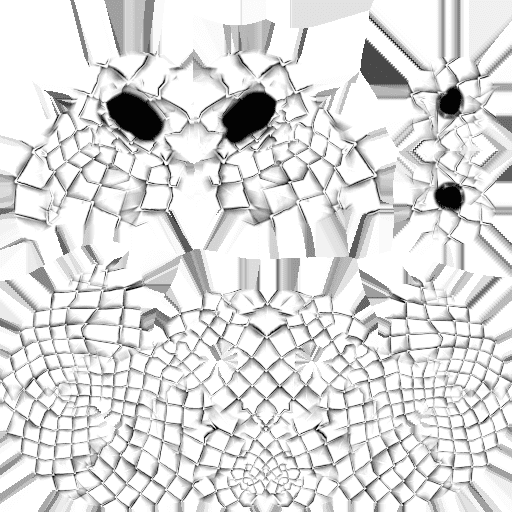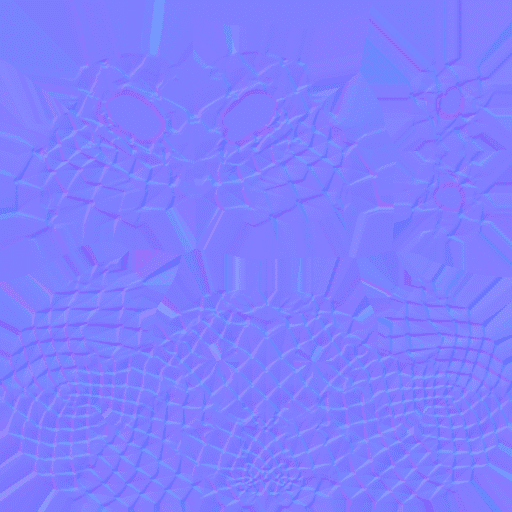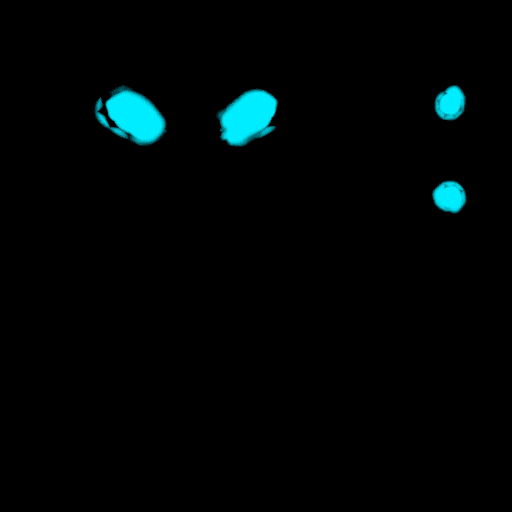OpenGLで物理ベースシェーディングを書いてみる
はじめに
この記事はシリーズ記事です。目次はこちら。
この記事では簡易的な物理ベースシェーダーでモデルを表示するところまでを行います。
モデルとテクスチャの用意
今回利用するモデルは以前に利用した猿のモデルです。
テクスチャは物理ベースシェーディングでよく使われるベースカラーとmetallic、roughness、normal、emissiveの5枚を用意します。
ベースカラーテクスチャは次の通り。
metallicテクスチャは次の通り。
roughnessテクスチャは次の通り。

Normalテクスチャは次の通り。
Emissiveテクスチャは次の通り。
これらのテクスチャはSubstance Painterで作成しました。
ベースカラーとEmissiveテクスチャはsRGBで、それ以外はLinearで書き出しているので、読み込むときにはそのように設定します。
前回からのプログラムの変更点
前回のプログラムからの変更点を次に示します。
Materialクラスの変更点
各種テクスチャをMaterialクラスに追加します。 また、emissiveの強さも格納することにします。
class Material {
publiglsl:
const Texture albedo_map_;
const Texture metallic_map_; const Texture roughness_map_; const Texture normal_map_;
const Texture emissive_map_; const GLfloat emissive_intensity_;
/**
* @brief コンストラクタ
* @param albedo_map アルベドテクスチャ
* @param metallic_map メタリックテクスチャ * @param roughnness_map ラフネステクスチャ * @param normal_map ノーマルマップテクスチャ
* @param emissive_map エミッシブテクスチャ * @param emissive_intensity エミッシブの強さ *
* 各種テクスチャとEmissiveの強さを指定してインスタンスを作成します。 */
Material(Texture&& albedo_map, Texture&& metallic_map, Texture&& roughness_map, Texture&& normal_map, Texture&& emissive_map, const GLfloat emissive_intensity);};Material::Material(Texture&& albedo_map, Texture&& metallic_map,
Texture&& roughness_map, Texture&& normal_map,
Texture&& emissive_map, const GLfloat emissive_intensity)
: albedo_map_(std::move(albedo_map)),
metallic_map_(std::move(metallic_map)),
roughness_map_(std::move(roughness_map)),
normal_map_(std::move(normal_map)),
emissive_map_(std::move(emissive_map)),
emissive_intensity_(emissive_intensity) {}Applicationクラスの変更点
emissiveIntensityをシェーダに渡すためにUniform Locationを取得します。
private:
GLFWwindow* window_;
GLuint program_;
GLuint model_loc_;
GLuint model_it_loc_;
GLuint view_projection_loc_;
GLuint world_camera_position_loc_;
GLuint emissive_intensity_loc_; std::vector<MeshEntity> mesh_entities_;
std::unique_ptr<Camera> camera_; // Uniform変数の位置を取得
model_loc_ = glGetUniformLocation(program_, "Model");
model_it_loc_ = glGetUniformLocation(program_, "ModelIT");
view_projection_loc_ = glGetUniformLocation(program_, "ViewProjection");
world_camera_position_loc_ =
glGetUniformLocation(program_, "worldCameraPosition");
emissive_intensity_loc_ = glGetUniformLocation(program_, "emissiveIntensity");読み込むメッシュを変更します。
// Meshの読み込み
auto mesh = Mesh::LoadObjMesh("monkey.obj");Materialの作成部分を変更します。
// Materialの作成
auto material = std::make_shared<Material>( Texture("monkey_BaseColor.png", true), Texture("monkey_Metallic.png", false), Texture("monkey_Roughness.png", false), Texture("monkey_Normal.png", false), Texture("monkey_Emissive.png", true), 10.0f);Emissiveの強さとして適当に10を設定しています。
Update部分を変更します。
for (auto&& mesh_entity : mesh_entities_) {
auto model = mesh_entity.GetModelMatrix();
auto model_it = glm::inverseTranspose(model);
glUniformMatrix4fv(model_loc_, 1, GL_FALSE, &model[0][0]);
glUniformMatrix4fv(model_it_loc_, 1, GL_FALSE, &model_it[0][0]);
glUniform1f(emissive_intensity_loc_, mesh_entity.material_->emissive_intensity_);
glActiveTexture(GL_TEXTURE0);
glBindTexture(GL_TEXTURE_2D,
mesh_entity.material_->albedo_map_.GetTextureId());
glActiveTexture(GL_TEXTURE1); glBindTexture(GL_TEXTURE_2D, mesh_entity.material_->metallic_map_.GetTextureId()); glActiveTexture(GL_TEXTURE2); glBindTexture(GL_TEXTURE_2D, mesh_entity.material_->roughness_map_.GetTextureId()); glActiveTexture(GL_TEXTURE3); glBindTexture(GL_TEXTURE_2D, mesh_entity.material_->normal_map_.GetTextureId()); glActiveTexture(GL_TEXTURE4); glBindTexture(GL_TEXTURE_2D, mesh_entity.material_->emissive_map_.GetTextureId()); mesh_entity.mesh_->Draw();
}シェーダの変更点
頂点シェーダは変わらずです。 フラグメントシェーダの変更点はたくさんあるので順に見ていきます。
まずはUniform変数を受け取る部分の変更です。
uniform vec3 worldCameraPosition;
uniform float emissiveIntensity;
layout (binding = 0) uniform sampler2D albedoMap;
layout (binding = 1) uniform sampler2D metallicMap;layout (binding = 2) uniform sampler2D roughnessMap;layout (binding = 3) uniform sampler2D normalMap;layout (binding = 4) uniform sampler2D emissiveMap;次に定数を用意します。
const float PI = 3.1415926536;
const float HALF_MAX = 65504.0;次にライトの設定です。 今回はライトの情報をシェーダにベタ書きします。 ライトをプログラムから変えるためにはUniform変数に入れる必要がありますが、今回はかんたんのためシェーダに直接書くということで……。
今回はポイントライトを3つ用意しました。
vec3[3] worldLightPositions = vec3[](
vec3(0, 5, 2),
vec3(3, 0, 5),
vec3(-3, 0, 5)
);
vec3[3] lightColors = vec3[](
vec3(1, 1, 1),
vec3(0.5, 0.8, 1),
vec3(0.5, 1, 0.8)
);
float[3] lightIntensities = float[]( // lm
1200,
800,
600
);ポイントライトの強さはlm(ルーメン)のつもりです。
ポイントライト用の減衰を計算する関数を用意します。
をベースに、0除算を避けるためEPSILONを追加し、離れた位置での影響を0にするため窓関数をかけています。
float DistanceAttenuation(float distance, float lightRange)
{
float EPSILON = 0.01;
float att = 1.0 / (distance * distance + EPSILON);
float smoothatt = 1 - pow(distance / lightRange, 4.0);
smoothatt = max(smoothatt, 0.0);
smoothatt = smoothatt * smoothatt;
return att * smoothatt;
}次にBRDFの実装です。
vec3 NormalizedLambert(vec3 diffuseColor) {
return diffuseColor / PI;
}
vec3 F_Schlick(vec3 F0, vec3 H, vec3 V) {
return (F0 + (1.0 - F0) * pow(1.0 - max(dot(V, H), 0), 5.0));
}
float D_GGX(float a, float NoH) {
float a2 = a * a;
float NoH2 = NoH * NoH;
float d = NoH2 * (a2 - 1.0) + 1.0;
return a2 / (PI * d * d);
}
float G_SchlickGGX(float a, float NoV) {
float EPSILON = 0.001;
float k = a * a / 2 + EPSILON;
float up = NoV;
float down = NoV * (1 - k) + k;
return up / down;
}
float G_Smith(float a, float NoV, float NoL) {
float ggx0 = G_SchlickGGX(1, NoV);
float ggx1 = G_SchlickGGX(1, NoL);
return ggx0 * ggx1;
}
vec3 BRDF(vec3 albedo, float metallic, float roughness, vec3 N, vec3 V, vec3 L, vec3 H) {
float EPSILON = 0.001;
vec3 F0 = mix(vec3(0.04), albedo, metallic);
float NoH = max(dot(N, H), 0);
float NoV = max(dot(N, V), 0);
float NoL = max(dot(N, L), 0);
float a = roughness * roughness;
// specular
vec3 F = F_Schlick(F0, H, V);
float D = D_GGX(a, NoH);
float G = G_Smith(a, NoV, NoL);
vec3 up = F * D * G;
float down = max(4.0 * NoV * NoL, EPSILON);
vec3 specular = up / down;
// diffuse
vec3 diffuse = NormalizedLambert(albedo);
vec3 kD = vec3(1.0) - F;
kD *= 1.0 - metallic;
return kD * diffuse + specular;
}ゼロ除算を避けるために適当にEPSILONが追加されていますが、基本的に前回の数式通りに実装しています。
exposureの値を与えています。
今回はこれもシェーダに直接書いていますが、本来はプログラムから渡すようにすべきでしょう。
今回は適当に0.2を与えています。
const float exposure = 0.2;次にACESを実装していきます。 基本的に次のページのコードをglslに直したものです。
aces-dev/transforms/ctl at master · ampas/aces-dev
// https://github.com/ampas/aces-dev
//
// Academy Color Encoding System (ACES) software and tools are provided by the
// Academy under the following terms and conditions: A worldwide, royalty-free,
// non-exclusive right to copy, modify, create derivatives, and use, in source
// and binary forms, is hereby granted, subject to acceptance of this license.
//
// Copyright 2018 Academy of Motion Picture Arts and Sciences (A.M.P.A.S.).
// Portions contributed by others as indicated. All rights reserved.
//
// Performance of any of the aforementioned acts indicates acceptance to be
// bound by the following terms and conditions:
//
// * Copies of source code, in whole or in part, must retain the above
// copyright notice, this list of conditions and the Disclaimer of Warranty.
//
// * Use in binary form must retain the above copyright notice, this list of
// conditions and the Disclaimer of Warranty in the documentation and/or
// other materials provided with the distribution.
//
// * Nothing in this license shall be deemed to grant any rights to trademarks,
// copyrights, patents, trade secrets or any other intellectual property of
// A.M.P.A.S. or any contributors, except as expressly stated herein.
//
// * Neither the name "A.M.P.A.S." nor the name of any other contributors to
// this software may be used to endorse or promote products derivative of or
// based on this software without express prior written permission of
// A.M.P.A.S. or the contributors, as appropriate.
//
// This license shall be construed pursuant to the laws of the State of
// California, and any disputes related thereto shall be subject to the
// jurisdiction of the courts therein.
//
// Disclaimer of Warranty: THIS SOFTWARE IS PROVIDED BY A.M.P.A.S. AND
// CONTRIBUTORS "AS IS" AND ANY EXPRESS OR IMPLIED WARRANTIES, INCLUDING, BUT
// NOT LIMITED TO, THE IMPLIED WARRANTIES OF MERCHANTABILITY, FITNESS FOR A
// PARTICULAR PURPOSE, AND NON-INFRINGEMENT ARE DISCLAIMED. IN NO EVENT SHALL
// A.M.P.A.S., OR ANY CONTRIBUTORS OR DISTRIBUTORS, BE LIABLE FOR ANY DIRECT,
// INDIRECT, INCIDENTAL, SPECIAL, EXEMPLARY, RESITUTIONARY, OR CONSEQUENTIAL
// DAMAGES (INCLUDING, BUT NOT LIMITED TO, PROCUREMENT OF SUBSTITUTE GOODS OR
// SERVICES; LOSS OF USE, DATA, OR PROFITS; OR BUSINESS INTERRUPTION) HOWEVER
// CAUSED AND ON ANY THEORY OF LIABILITY, WHETHER IN CONTRACT, STRICT
// LIABILITY, OR TORT (INCLUDING NEGLIGENCE OR OTHERWISE) ARISING IN ANY WAY
// OUT OF THE USE OF THIS SOFTWARE, EVEN IF ADVISED OF THE POSSIBILITY OF SUCH
// DAMAGE.
//
// WITHOUT LIMITING THE GENERALITY OF THE FOREGOING, THE ACADEMY SPECIFICALLY
// DISCLAIMS ANY REPRESENTATIONS OR WARRANTIES WHATSOEVER RELATED TO PATENT OR
// OTHER INTELLECTUAL PROPERTY RIGHTS IN THE ACADEMY COLOR ENCODING SYSTEM, OR
// APPLICATIONS THEREOF, HELD BY PARTIES OTHER THAN A.M.P.A.S.,WHETHER
// DISCLOSED OR UNDISCLOSED.
//
// ############################################################################
// https://github.com/ampas/aces-dev/blob/master/transforms/ctl/README-MATRIX.md
const mat3 sRGB_2_AP0 = mat3(
0.4397010, 0.0897923, 0.0175440,
0.3829780, 0.8134230, 0.1115440,
0.1773350, 0.0967616, 0.8707040
);
const mat3 AP0_2_AP1_MAT = mat3(
1.4514393161, -0.0765537734, 0.0083161484,
-0.2365107469, 1.1762296998, -0.0060324498,
-0.2149285693, -0.0996759264, 0.9977163014
);
const mat3 AP1_2_AP0_MAT = mat3(
0.6954522414, 0.0447945634, -0.0055258826,
0.1406786965, 0.8596711185, 0.0040252103,
0.1638690622, 0.0955343182, 1.0015006723
);
const mat3 AP1_2_XYZ_MAT = mat3(
0.6624541811, 0.2722287168, -0.0055746495,
0.1340042065, 0.6740817658, 0.0040607335,
0.1561876870, 0.0536895174, 1.0103391003
);
const mat3 XYZ_2_AP1_MAT = mat3(
1.6410233797, -0.6636628587, 0.0117218943,
-0.3248032942, 1.6153315917, -0.0082844420,
-0.2364246952, 0.0167563477, 0.9883948585
);
const mat3 XYZ_2_REC709_MAT = mat3(
3.2409699419, -0.9692436363, 0.0556300797,
-1.5373831776, 1.8759675015, -0.2039769589,
-0.4986107603, 0.0415550574, 1.0569715142
);
const mat3 RRT_SAT_MAT = mat3(
0.9708890, 0.0108892, 0.0108892,
0.0269633, 0.9869630, 0.0269633,
0.00214758, 0.00214758, 0.96214800
);
const mat3 ODT_SAT_MAT = mat3(
0.949056, 0.019056, 0.019056,
0.0471857, 0.9771860, 0.0471857,
0.00375827, 0.00375827, 0.93375800
);
const mat3 D60_2_D65_CAT = mat3(
0.98722400, -0.00759836, 0.00307257,
-0.00611327, 1.00186000, -0.00509595,
0.0159533, 0.0053302, 1.0816800
);
float log10(float x)
{
return log2(x) / log2(10.0);
}
vec3 sRGBToACES(vec3 srgb)
{
return sRGB_2_AP0 * srgb;
}
float min_f3(vec3 a)
{
return min(a.x, min(a.y, a.z));
}
float max_f3(vec3 a)
{
return max(a.x, max(a.y, a.z));
}
float rgb_2_saturation(vec3 rgb)
{
const float TINY = 1e-10;
float mi = min_f3(rgb);
float ma = max_f3(rgb);
return (max(ma, TINY) - max(mi, TINY)) / max(ma, 1e-2);
}
float rgb_2_yc(vec3 rgb)
{
const float ycRadiusWeight = 1.75;
float r = rgb.r;
float g = rgb.g;
float b = rgb.b;
float chroma = sqrt(b * (b - g) + g * (g - r) + r * (r - b));
return (b + g + r + ycRadiusWeight * chroma) / 3.0;
}
float sigmoid_shaper(float x)
{
float t = max(1.0 - abs(x / 2.0), 0.0);
float y = 1.0 + sign(x) * (1.0 - t * t);
return y / 2.0;
}
float glow_fwd(float ycIn, float glowGainIn, float glowMid)
{
float glowGainOut;
if (ycIn <= 2.0 / 3.0 * glowMid)
glowGainOut = glowGainIn;
else if (ycIn >= 2.0 * glowMid)
glowGainOut = 0.0;
else
glowGainOut = glowGainIn * (glowMid / ycIn - 1.0 / 2.0);
return glowGainOut;
}
float rgb_2_hue(vec3 rgb)
{
float hue;
if (rgb.r == rgb.g && rgb.g == rgb.b)
hue = 0.0;
else
hue = (180.0 / PI) * atan(sqrt(3.0) * (rgb.g - rgb.b), 2.0 * rgb.r - rgb.g - rgb.b);
if (hue < 0.0) hue = hue + 360.0;
return hue;
}
float center_hue(float hue, float centerH)
{
float hueCentered = hue - centerH;
if (hueCentered < -180.0) hueCentered = hueCentered + 360.0;
else if (hueCentered > 180.0) hueCentered = hueCentered - 360.0;
return hueCentered;
}
float cubic_basis_shaper(float x, float w)
{
float M[4][4] = {
{ -1.0 / 6, 3.0 / 6, -3.0 / 6, 1.0 / 6 },
{ 3.0 / 6, -6.0 / 6, 3.0 / 6, 0.0 / 6 },
{ -3.0 / 6, 0.0 / 6, 3.0 / 6, 0.0 / 6 },
{ 1.0 / 6, 4.0 / 6, 1.0 / 6, 0.0 / 6}
};
float knots[5] = {
-w / 2.0,
-w / 4.0,
0.0,
w / 4.0,
w / 2.0
};
float y = 0.0;
if ((x > knots[0]) && (x < knots[4]))
{
float knot_coord = (x - knots[0]) * 4.0 / w;
int j = int(knot_coord);
float t = knot_coord - j;
float monomials[4] = { t * t * t, t * t, t, 1.0 };
if (j == 3)
{
y = monomials[0] * M[0][0] + monomials[1] * M[1][0] + monomials[2] * M[2][0] + monomials[3] * M[3][0];
}
else if (j == 2)
{
y = monomials[0] * M[0][1] + monomials[1] * M[1][1] + monomials[2] * M[2][1] + monomials[3] * M[3][1];
}
else if (j == 1)
{
y = monomials[0] * M[0][2] + monomials[1] * M[1][2] + monomials[2] * M[2][2] + monomials[3] * M[3][2];
}
else if (j == 0)
{
y = monomials[0] * M[0][3] + monomials[1] * M[1][3] + monomials[2] * M[2][3] + monomials[3] * M[3][3];
}
else
{
y = 0.0;
}
}
return y * 3.0 / 2.0;
}
const mat3 M = mat3(
0.5, -1.0, 0.5,
-1.0, 1.0, 0.5,
0.5, 0.0, 0.0
);
float segmented_spline_c5_fwd(float x)
{
const float coefsLow[6] = { -4.0000000000, -4.0000000000, -3.1573765773, -0.4852499958, 1.8477324706, 1.8477324706 };
const float coefsHigh[6] = { -0.7185482425, 2.0810307172, 3.6681241237, 4.0000000000, 4.0000000000, 4.0000000000 };
const vec2 minPoint = vec2(0.18 * exp2(-15.0), 0.0001);
const vec2 midPoint = vec2(0.18, 0.48);
const vec2 maxPoint = vec2(0.18 * exp2(18.0), 10000.0);
const float slopeLow = 0.0;
const float slopeHigh = 0.0;
const int N_KNOTS_LOW = 4;
const int N_KNOTS_HIGH = 4;
float xCheck = x;
if (xCheck <= 0.0) xCheck = 0.00006103515; // = pow(2.0, -14.0)
float logx = log10(xCheck);
float logy;
if (logx <= log10(minPoint.x))
{
logy = logx * slopeLow + (log10(minPoint.y) - slopeLow * log10(minPoint.x));
}
else if ((logx > log10(minPoint.x)) && (logx < log10(midPoint.x)))
{
float knot_coord = (N_KNOTS_LOW - 1) * (logx - log10(minPoint.x)) / (log10(midPoint.x) - log10(minPoint.x));
int j = int(knot_coord);
float t = knot_coord - j;
vec3 cf = vec3(coefsLow[j], coefsLow[j + 1], coefsLow[j + 2]);
vec3 monomials = vec3(t * t, t, 1.0);
logy = dot(monomials, M * cf);
}
else if((logx >= log10(midPoint.x)) && (logx < log10(maxPoint.x)))
{
float knot_coord = (N_KNOTS_HIGH - 1) * (logx - log10(midPoint.x)) / (log10(maxPoint.x) - log10(midPoint.x));
int j = int(knot_coord);
float t = knot_coord - j;
vec3 cf = vec3(coefsHigh[j], coefsHigh[j + 1], coefsHigh[j + 2]);
vec3 monomials = vec3(t * t, t , 1.0);
logy = dot(monomials, M * cf);
}
else
{
logy = logx * slopeHigh + (log10(maxPoint.y) - slopeHigh * log10(maxPoint.x));
}
return pow(10.0, logy);
}
float segmented_spline_c9_fwd(float x)
{
const float coefsLow[10] = { -1.6989700043, -1.6989700043, -1.4779000000, -1.2291000000, -0.8648000000, -0.4480000000, 0.0051800000, 0.4511080334, 0.9113744414, 0.9113744414 };
const float coefsHigh[10] = { 0.5154386965, 0.8470437783, 1.1358000000, 1.3802000000, 1.5197000000, 1.5985000000, 1.6467000000, 1.6746091357, 1.6878733390, 1.6878733390 };
const vec2 minPoint = vec2(segmented_spline_c5_fwd(0.18 * exp2(-6.5)), 0.02);
const vec2 midPoint = vec2(segmented_spline_c5_fwd(0.18), 4.8);
const vec2 maxPoint = vec2(segmented_spline_c5_fwd(0.18 * exp2(6.5)), 48.0);
const float slopeLow = 0.0;
const float slopeHigh = 0.04;
const int N_KNOTS_LOW = 8;
const int N_KNOTS_HIGH = 8;
float xCheck = x;
if (xCheck <= 0.0) xCheck = 1e-4;
float logx = log10(xCheck);
float logy;
if (logx <= log10(minPoint.x))
{
logy = logx * slopeLow + (log10(minPoint.y) - slopeLow * log10(minPoint.x));
}
else if ((logx > log10(minPoint.x)) && (logx < log10(midPoint.x)))
{
float knot_coord = (N_KNOTS_LOW - 1) * (logx - log10(minPoint.x)) / (log10(midPoint.x) - log10(minPoint.x));
int j = int(knot_coord);
float t = knot_coord - j;
vec3 cf = vec3(coefsLow[j], coefsLow[j + 1], coefsLow[j + 2]);
vec3 monomials = vec3(t * t, t, 1.0);
logy = dot(monomials, M * cf);
}
else if ((logx >= log10(midPoint.x)) && (logx < log10(maxPoint.x)))
{
float knot_coord = (N_KNOTS_HIGH - 1) * (logx - log10(midPoint.x)) / (log10(maxPoint.x) - log10(midPoint.x));
int j = int(knot_coord);
float t = knot_coord - j;
vec3 cf = vec3(coefsHigh[j], coefsHigh[j + 1], coefsHigh[j + 2]);
vec3 monomials = vec3(t * t, t, 1.0);
logy = dot(monomials, M * cf);
}
else
{
logy = logx * slopeHigh + (log10(maxPoint.y) - slopeHigh * log10(maxPoint.x));
}
return pow(10.0, logy);
}
const float RRT_GLOW_GAIN = 0.05;
const float RRT_GLOW_MID = 0.08;
const float RRT_RED_SCALE = 0.82;
const float RRT_RED_PIVOT = 0.03;
const float RRT_RED_HUE = 0.0;
const float RRT_RED_WIDTH = 135.0;
const float RRT_SAT_FACTOR = 0.96;
vec3 RRT(vec3 aces)
{
// --- Glow module --- //
float saturation = rgb_2_saturation(aces);
float ycIn = rgb_2_yc(aces);
float s = sigmoid_shaper((saturation - 0.4) / 0.2);
float addedGlow = 1.0 + glow_fwd(ycIn, RRT_GLOW_GAIN * s, RRT_GLOW_MID);
aces *= addedGlow;
// --- Red modifier --- //
float hue = rgb_2_hue(aces);
float centeredHue = center_hue(hue, RRT_RED_HUE);
float hueWeight = cubic_basis_shaper(centeredHue, RRT_RED_WIDTH);
aces.r += hueWeight * saturation * (RRT_RED_PIVOT - aces.r) * (1.0 - RRT_RED_SCALE);
// --- ACES to RGB rendering space --- //
aces = clamp(aces, 0.0, HALF_MAX); // avoids saturated negative colors from becoming positive in the matrix
vec3 rgbPre = AP0_2_AP1_MAT * aces;
rgbPre = clamp(rgbPre, 0.0, HALF_MAX);
// --- Global desaturation --- //
rgbPre = RRT_SAT_MAT * rgbPre;
// --- Apply the tonescale independently in rendering-space RGB --- //
vec3 rgbPost;
rgbPost.x = segmented_spline_c5_fwd(rgbPre.x);
rgbPost.y = segmented_spline_c5_fwd(rgbPre.y);
rgbPost.z = segmented_spline_c5_fwd(rgbPre.z);
// --- RGB rendering space to OCES --- //
vec3 rgbOces = AP1_2_AP0_MAT * rgbPost;
// Assign OCES RGB to output variables (OCES)
return rgbOces;
}
vec3 Y_2_linCV(vec3 Y, float Ymax, float Ymin)
{
return (Y - Ymin) / (Ymax - Ymin);
}
vec3 XYZ_2_xyY(vec3 XYZ)
{
float divisor = max(dot(XYZ, (1.0).xxx), 1e-4);
return vec3(XYZ.xy / divisor, XYZ.y);
}
vec3 xyY_2_XYZ(vec3 xyY)
{
float m = xyY.z / max(xyY.y, 1e-4);
vec3 XYZ = vec3(xyY.xz, (1.0 - xyY.x - xyY.y));
XYZ.xz *= m;
return XYZ;
}
const float DIM_SURROUND_GAMMA = 0.9811;
vec3 darkSurround_to_dimSurround(vec3 linearCV)
{
vec3 XYZ = AP1_2_XYZ_MAT * linearCV;
vec3 xyY = XYZ_2_xyY(XYZ);
xyY.z = clamp(xyY.z, 0.0, HALF_MAX);
xyY.z = pow(xyY.z, DIM_SURROUND_GAMMA);
XYZ = xyY_2_XYZ(xyY);
return XYZ_2_AP1_MAT * XYZ;
}
float moncurve_r(float y, float gamma, float offs)
{
// Reverse monitor curve
float x;
const float yb = pow(offs * gamma / ((gamma - 1.0) * (1.0 + offs)), gamma);
const float rs = pow((gamma - 1.0) / offs, gamma - 1.0) * pow((1.0 + offs) / gamma, gamma);
if (y >= yb)
x = (1.0 + offs) * pow(y, 1.0 / gamma) - offs;
else
x = y * rs;
return x;
}
const float CINEMA_WHITE = 48.0;
const float CINEMA_BLACK = CINEMA_WHITE / 2400.0;
// NOTE: The EOTF is *NOT* gamma 2.4, it follows IEC 61966-2-1:1999
const float DISPGAMMA = 2.4;
const float OFFSET = 0.055;
vec3 ODT_RGBmonitor_100nits_dim(vec3 oces)
{
// OCES to RGB rendering space
vec3 rgbPre = AP0_2_AP1_MAT * oces;
// Apply the tonescale independently in rendering-space RGB
vec3 rgbPost;
rgbPost.x = segmented_spline_c9_fwd(rgbPre.x);
rgbPost.y = segmented_spline_c9_fwd(rgbPre.y);
rgbPost.z = segmented_spline_c9_fwd(rgbPre.z);
// Scale luminance to linear code value
vec3 linearCV = Y_2_linCV(rgbPost, CINEMA_WHITE, CINEMA_BLACK);
// Apply gamma adjustment to compensate for dim surround
linearCV = darkSurround_to_dimSurround(linearCV);
// Apply desaturation to compensate for luminance difference
linearCV = ODT_SAT_MAT * linearCV;
// Convert to display primary encoding
// Rendering space RGB to XYZ
vec3 XYZ = AP1_2_XYZ_MAT * linearCV;
// Apply CAT from ACES white point to assumed observer adapted white point
XYZ = D60_2_D65_CAT * XYZ;
// CIE XYZ to display primaries
// linearCV = XYZ_2_DISPLAY_PRI_MAT * XYZ;
linearCV = XYZ_2_REC709_MAT * XYZ;
// Handle out-of-gamut values
// Clip values < 0 or > 1 (i.e. projecting outside the display primaries)
linearCV = clamp(linearCV, 0.0 , 1.0);
vec3 outputCV;
outputCV.x = moncurve_r(linearCV.x, DISPGAMMA, OFFSET);
outputCV.y = moncurve_r(linearCV.y, DISPGAMMA, OFFSET);
outputCV.z = moncurve_r(linearCV.z, DISPGAMMA, OFFSET);
return outputCV;
}
vec3 ACESTonemapping(vec3 aces)
{
return ODT_RGBmonitor_100nits_dim(RRT(aces));
}今回はODTは普通のRGBモニター用と思われるODT_RGBmonitor_100nits_dimのみ実装しています。
この他にHDRモニターなど様々なモニタ用に専用のODTが用意されています。
ガンマ補正のコードを追加します。
const float SCALE_0= 1.0/12.92;
const float SCALE_1= 1.0/1.055;
const float OFFSET_1= 0.055 * SCALE_1;
float LinearToSRGB_F( float color )
{
color= clamp( color, 0.0, 1.0 );
if( color < 0.0031308 ){
return color * 12.92;
}
return 1.055 * pow( color, 0.41666 ) - 0.055;
}
vec3 LinearToSRGB( vec3 color )
{
return vec3(
LinearToSRGB_F( color.x ),
LinearToSRGB_F( color.y ),
LinearToSRGB_F( color.z ) );
}最後にmain関数は次のようになります。
void main() {
vec3 albedo = sRGBToACES(texture(albedoMap, vUv).rgb);
float metallic = texture(metallicMap, vUv).r;
float roughness = texture(roughnessMap, vUv).r;
vec3 emissive = sRGBToACES(texture(emissiveMap, vUv).rgb);
vec3 color = emissive * emissiveIntensity;
vec3 N = GetNormal();
vec3 V = normalize(worldCameraPosition - vWorldPosition);
for (int i = 0; i < 3; i++) {
vec3 L = normalize(worldLightPositions[i] - vWorldPosition);
vec3 H = normalize(L + V);
float attenuation =
DistanceAttenuation(distance(worldLightPositions[i], vWorldPosition), 20.0);
vec3 irradiance =
lightIntensities[i] / (4.0 * PI) * attenuation * sRGBToACES(lightColors[i]) * max(dot(N, L), 0);
color += BRDF(albedo, metallic, roughness, N, V, L, H) * irradiance;
}
color *= exposure;
color = ACESTonemapping(color);
color = LinearToSRGB(color);
fragment = vec4(color, 1.0);
}最初にテクスチャ情報を読み取っています。 色情報についてはACES色空間でレンダリングを行うために、sRGBからACESに変換しています。
最初にcolorにemissive項を入れています。
幾何情報のNとVについては前回と変わりません。
for文でポイントライト3つについて回しています。
幾何情報のLとHを計算しています。
ポイントライトの距離による減衰を計算し、色とコサイン項を掛けて、ポイントライトからの放射照度を求めます。
この放射照度をBRDFに掛け合わせてこのポイントライトによるローカルな反射を計算しました。
計算した放射輝度に露出をかけて、ACESのトーンマッピングをかけてガンマ補正を計算して最終的な色を計算しています。
実行結果
実行結果は次のとおりです。
プログラム全文
プログラム全文はGitHubにアップロードしてあります。






